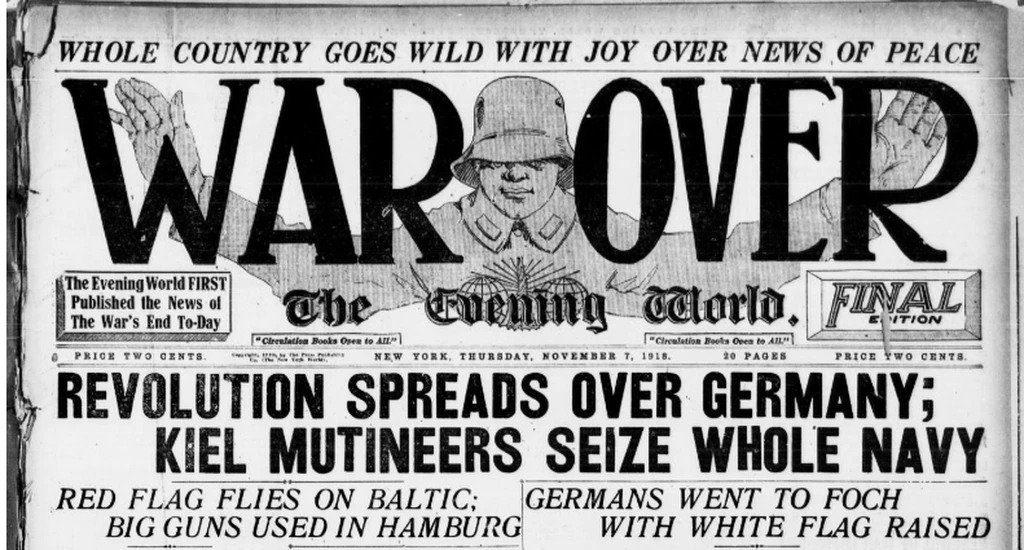The greatest war in history came to an end on November 11, but not without a final cruel twist.
-
November 1993
Volume44Issue7

The greatest war in history came to an end on November 11, but not without a final cruel twist. On November 7 Roy W. Howard, president of the United Press Association, received what he thought was the scoop of the year from a group of jubilant French sailors docking at Brest Harbor, while he himself was waiting to sail for America. Using the offices of La Dépêche , Howard cabled the incredible news to New York, adding the name of his Paris office manager, Philip Simms, to the cable out of courtesy: “URGENT. ARMISTICE ALLIES GERMANS SIGNED ELEVEN [THI]SMORNING HOSTILITIES CEASED TWO [THI]SAFTERNOON. SEDAN TAKEN [THI]SMORNING BY AMERICANS .”
Simms’s name gave the local rumor a credence it might not otherwise have had. The Brest censor assumed the story had originated in Paris and passed it on; in New York the United Press office in the Pulitzer Building on Park Row received the “urgent” cable at noon. The message had apparently come from Paris, and it received the censor’s okay at eleven fifty-nine. The story was immediately fed by wire to hundreds of subscribing newspapers in time to make their early-afternoon editions. Even as Arthur Hornblow, Jr., of the American Expeditionary Forces intelligence staff in Brest, was calling Paris to confirm the story for Howard, every city in America was starting to ring out the peace. No one in military intelligence in the French capital could verify; news of the signing, now common knowledge in delirious Brest, was Howard’s to tell.
The UP story unleashed happy riots in New York, Chicago, Boston, San Francisco, and a thousand small towns in between. The gates of the shipyard in Quincy, Massachusetts, were shoved aside as soon as word got out, and ten thousand shipyard workers paraded through town, waving their picks and shovels. In Minnesota a celebratory shot from a cannon injured carousers; in Chicago police clubbed revelers to keep order. Bells, air-raid sirens, and factory whistles signaled the armistice in New York at 1:00 P.M. , and the streets filled immediately. Shop owners shut down for the day, posting signs that read TOO HAPPY TO WORK or CLOSED FOR THE KAISER’S FUNERAL, and impromptu parades carried makeshift “coffins” for the German leader. Many schools and courts were dismissed; the stock exchange closed.
By dusk the streets were ankle-deep in tons of ticker tape, wastepaper, and torn-up telephone books; hundreds of calls were placed to the sanitation commission complaining about windowsills clogged with the confetti. At the Knickerbocker Hotel one elated couple—a portly man and a woman in furs—swung large Italian and American flags above the commotion at Forty-second Street. They were the Enrico Carusos. (He would soon be singing in Verdi’s La Forza del Destina at the Met.) When the house band from the Rialto Theater was coaxed over to the hotel, the tenor sang “The StarSpangled Banner” from his balcony, then dropped an armful of red roses down on the crowd.
It was “a delirious carnival of joy” beyond comparison for the city, claimed The New York Times, one of the few papers that never ran Howard’s story and “stuck to less romantic realities.” Although the fake was discovered by late afternoon, many newsboys continued to hawk the good news, and people kept buying the earlier editions into the evening. JUBILANT THRONGS REJECT ALL DENIALS AND TEAR UP NEWSPAPERS CONTAINING THEM, chided the paper of record the next day.
The British papers had largely been more cautious, but in France, Australia, Argentina, and even Cuba people were celebrating. In Washington President Woodrow Wilson was drawn out of the White House long enough to smile for a cheering armistice crowd, even though he knew that the news was untrue. Mrs. Wilson traveled into the capital to see the ecstatic mobs and said nothing discouraging from her open car. Meanwhile, the State Department (through the Navy censor) had intercepted and stopped Roy Howard’s less confident second cable to New York, leaving the UP office there with a false confidence in its armistice. Secretary of State Lansing released a denial at 4:00 P.M., but outside, the party raged on.
Howard was not the only reporter spreading peace rumors that day: patrons in the Paris press bars sang and toasted the peace all afternoon on the basis of a story that supposedly began with the American Embassy, which later made an official correction. The British Bureau of Information in New York also received word of an armistice that day, in a cable from an excited British lieutenant.
The real thing came four days after the enormous rehearsal; it was signed by the defeated Germans at five in the morning, to take effect at the eleventh hour of the eleventh day in the eleventh month. Malcolm Cowley, who had disbelieved the first armistice, hailed the real one when it came. “We danced in the streets,” he recalled, “embraced old women and pretty girls, swore blood brotherhood with soldiers in little bars, drank with our elbows locked in theirs, reeled through the streets with bottles of champagne, fell asleep somewhere.”

